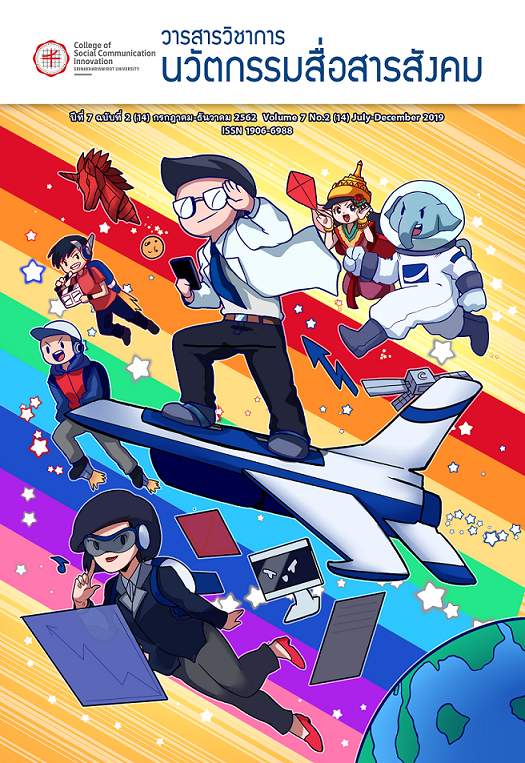การส่งเสริมทรัพยากรวัฒนธรรมในการท่องเที่ยวเชิงสร้างสรรค์ผ่านสื่อภาพยนตร์โฆษณาของชุมชนระโนด จังหวัดสงขลา
Keywords:
ทรัพยากรวัฒนธรรม, การท่องเที่ยวเชิงสร้างสรรค์, ภาพยนตร์โฆษณา, Cultural resource, Creative tourism, Television commercialAbstract
The promotion of cultural resource in creative tourism through the television commercial of Ranod community, Songkhla provinceบทคัดย่อ การวิจัยชิ้นนี้เป็นการวิจัยแบบผสมผสาน ประเภทการออกแบบการวิจัยและพัฒนา มีวัตถุประสงค์ 3 ประการ คือ 1) เพื่อศึกษาและประเมินความสำคัญทรัพยากรวัฒนธรรมเพื่อการท่องเที่ยวเชิงสร้างสรรค์ของชุมชนระโนด 2) เพื่อผลิตสื่อภาพยนตร์โฆษณาเพื่อส่งเสริมการท่องเที่ยวเชิงสร้างสรรค์ของชุมชนระโนด และ 3) เพื่อทดสอบความสัมพันธ์ของภาพยนตร์โฆษณากับความสนใจและต้องการท่องเที่ยวเชิงสร้างสรรค์ชุมชนระโนดของนักท่องเที่ยว เริ่มจากการศึกษาเอกสารและการสัมภาษณ์ชาวบ้านในชุมชนระโนด จำนวน 35 คน ได้แก่ ชาวบ้าน ผู้บริหารส่วนท้องถิ่น และนักวิชาการทางวัฒนธรรม และประเมินความคิดเห็นเชิงปริมาณของชาวบ้านในพื้นที่ 8 ชุมชนของเทศบาลตำบลระโนด จำนวน 363 คน จากนั้นนำข้อมูลทั้งหมดไปสร้างเป็นผลงานภาพยนตร์การท่องเที่ยวเชิงสร้างสรรค์ของชุมชนระโนด โดยให้ผู้ทรงคุณวุฒิประเมินคุณภาพผลงานก่อนนำไปเผยแพร่ผ่าน Youtube และสำรวจความสนใจและต้องการท่องเที่ยวชุมชนระโนดของนักท่องเที่ยวจำนวน 400 หลังจากได้ชมภาพยนตร์ดังกล่าวผ่านสื่อออนไลน์ ผลการวิจัยสามารถสรุปได้ดังนี้ 1) ทรัพยากรวัฒนธรรมเพื่อการท่องเที่ยวของชุมชนระโนด มี 2 ประเภท คือสถานที่ตั้งทางวัฒนธรรมและวิถีชีวิต ที่ผูกพันกับประวัติศาสตร์และความเป็นอยู่ของชุมชน ชาวบ้านส่วนใหญ่ ตระหนักความสำคัญในทรัพยากรวัฒนธรรมในระดับปานกลาง ( = 2.75) โดยพื้นที่และอาคารบ้านเรือนริมคลองระโนดถูกมองว่าเป็นทรัพยากรวัฒนธรรมที่สำคัญที่สุด ( = 3.88 ) รองลงมาคือการเป็นเมืองทางผ่านทางคมนาคมในอดีต ( = 3.67) ซึ่งทรัพยากรวัฒนธรรมทั้งหมดสามารถปรับใช้ให้เข้ากับกิจกรรมท่องเที่ยวเชิงสร้างสรรค์โดยให้นักท่องเที่ยวเข้ามาส่วนร่วมในการออกแบบการท่องเที่ยวและเกิดการเรียนรู้ร่วมกับชุมชน 2) การผลิตสื่อภาพยนตร์โฆษณาเพื่อส่งเสริมการท่องเที่ยวเชิงสร้างสรรค์ของชุมชนระโนด เรื่อง “หลง (ระ) โนต” โดยเทคนิคการเล่าเรื่องแบบเสี้ยวหนึ่งของชีวิต ผ่านการเดินทางท่องเที่ยวที่ไม่ตั้งใจของหญิงสาวคนหนึ่ง ที่ผลัดหลงเข้าไปในเมืองระโนดโดยบังเอิญ และทำให้เธอหลงรักเสน่ห์ของผู้คน เรื่องราว และวิถีชีวิตของชุมชนระโนด ได้รับการประเมินคุณภาพผลงานจากผู้ทรงคุณวุฒิระดับดี ( =3.69) และ 3) การทดสอบความสัมพันธ์ของภาพยนตร์โฆษณากับความสนใจและต้องการท่องเที่ยวเชิงสร้างสรรค์ชุมชนระโนดของนักท่องเที่ยวจำนวน 400 คน ส่วนใหญ่เป็นหญิงจำนวน 264 คน (ร้อยละ 66) ชายจำนวน 136 คน (ร้อยละ 34) อายุระหว่าง 21-40 ปีมากที่สุด จำนวน 242 คน (ร้อยละ 60.5) รองลงมาคืออายุ 41-60 ปี จำนวน 90 คน (ร้อยละ 22.5) ส่วนใหญ่มีรายได้ประมาณ ต่ำกว่า 15,000 บาท จำนวน 127 คน (ร้อยละ 31.8) ภูมิลำเนาอยู่ในจังหวัดอื่นๆ ใน ภาคใต้มากที่สุด 200คน (ร้อยละ 50) และเดินทางมาท่องเที่ยวในเทศบาลระโนด ภายใน ระยะเวลา 1-5 ปีที่ผ่าน 190 คน (ร้อยละ 47.5 ) รู้จักทรัพยากรท่องเที่ยวทางวัฒนธรรมของชุมชนระโนดของกลุ่มตัวอย่างอยู่ในระดับปานกลาง ( =2.97) มีความพึงพอใจเกี่ยวกับวิดีทัศน์เรื่อง หลง (ระ) โนต อยู่ในระดับดีมาก ( =4.16) การสนใจและต้องการท่องเที่ยวเชิงสร้างสรรค์ในพื้นที่อำเภอระโนด หลังจากได้ชมวิดีทัศน์ เรื่อง หลง(ระ)โนต อยู่ในระดับดีมาก (=4.10) พบว่า ความสัมพันธ์ขององค์ประกอบของภาพยนตร์โฆษณากับความสนใจและต้องการท่องเที่ยวชุมชนระโนด มีนัยสำคัญทางสถิติที่ระดับ 0.01 มีค่าสัมประสิทธิ์สหสัมพันธ์ไปในทิศทางเดียวกันในระดับปานกลาง (r =0.427) โดยเสียงประกอบมีความสัมพันธ์อย่างมีนัยสำคัญทางสถิติมากที่สุด (r =0.496) รองลงมาคือการประโยชน์ของเนื้อหา (r =0.467) และการแสดงของนักแสดงนำ (r =0.442) ส่วนความยาวของภาพยนตร์มีความสัมพันธ์กับความสนใจและต้องการท่องเที่ยวเชิงสร้างสรรค์ของชุมชนระโนดน้อยที่สุด (r =0.366) เมื่อพิจารณารายข้อ ประโยชน์ของเนื้อหา (Sig = 0.002) และเสียงประกอบ (Sig = 0.002) ของภาพยนตร์ดังกล่าวมีอิทธิพลต่อความสนใจและต้องการท่องเที่ยวเชิงสร้างสรรค์ชุมชนระโนดได้มากถึงร้อยละ 32.7 คำสำคัญ: ทรัพยากรวัฒนธรรม / การท่องเที่ยวเชิงสร้างสรรค์ / ภาพยนตร์โฆษณาAbstract This research design was based on a research and development by using a mix-method in order to accomplish 3 purposes. 1) To study and evaluate in the importance of cultural resources for supporting Ranot community-based creative tourism. 2) To produce the advertisement film for promoting a creative tourism of Ranot community. 3) To analyze the correlation between the advertisement film and creative tourist demands. Both documentary studies and the in-depth interview were conducted at the beginning. The in-depth interview data were collected from 35 residents that included the Ranot villagers, the local administrators, and various cultural scholars. This study carried out in 8 communities of Ranot district about the opinion that 363 residents had in order to engage. All collected data were analyzed and created as the advertisement film promoting through the creative tourism which belong to Ranot community. The requirement of its quality evaluation had been considered by several experts before launching it via a Youtube program. This study explored how the advertisement film was related to the demand of tourists. Participants were 400 tourists conducted through convenience sampling. The research finding could be shown as follows: 1) The findings indicated that cultural resources for tourism in Ranot community were consisting of two types: the cultural sites and the way of life. It related to their history and well-being of the community. Most villagers concerned about the importance of cultural resources at a medium level (= 2.75), where the areas and houses site along the Ranot canal were regarded as the most important cultural resources (= 3.88), followed by being a city in the past via transportation (= 3.67 ), Which all cultural resources could be adapted for creative tourism activities by allowing tourists to participate in tourism design, and to learn with the community members. 2) The production of advertisement film promoting the creative tourism of Ranot community, "Long (Ra) Not", was using storytelling techniques. It talked about the unintentional traveling of the young woman tourist. By accidentally lost into the city of Ranot, it made her fall in love with the charming of the people there, the old story, and the way of life in Ranot community. Through the evaluation of the quality of professional level (= 3.69). And 3) Testing the correlation between the advertisement film and the tourist demands (interest and want) for traveling to the Ranot community was collected from 400 tourists. The finding indicated that mostly 264 women (66%), 136 men (34%) aged between 21-40 years old. The most are 242 people (60.5%), followed by 41-60 years of age, 90 people (22.5%), most of them had the incomes below 15,000 baht. 127 people (31.8%) were domiciled in other provinces. In the southern the most 200 people (50 %) had been travelling to Ranot municipality within the past 1-5 years, 190 people (47.5%) knew the cultural tourism resources of Ranot community of the sample group at a moderate level (= 2.97). They were satisfied with the advertisement film about “Long (Ra) Not”. In the high level (= 4.16), interested and creative tourism in Ranot district. After watching the film about “Long (Ra) Not” at a high level (= 4.10), it was found that the correlation between the advertisement film and the creative tourist demands were statistical significance at the level of 0.01. It had a correlation coefficient in the same direction at a moderate level (r = 0.427), with the sound having the highest statistical significance (r = 0.496), followed by the benefits of the content (r = 0.467) and the show of the leading actors (r = 0.442). The length of the movie had the least relations with the interest and the desire to travel to Ranot community (r = 0.366). After considering each program, it was found that the benefit of the content (Sig = 0.002) and the soundtrack (Sig = 0.002) of the said movie influenced the creative tourist demands for traveling to Ranot community up to 32.7 %.Keyword: Cultural resource, Creative tourism, Television commercial.Downloads
Download data is not yet available.
Downloads
Published
2019-12-30
Issue
Section
บทความวิจัย




